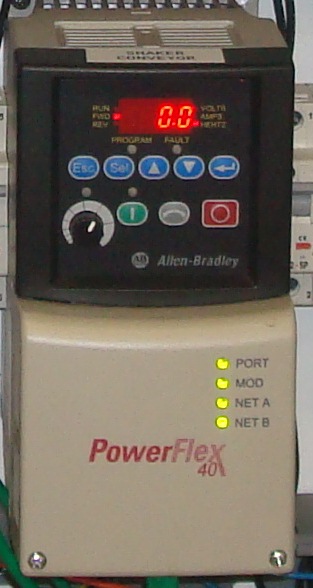The Effects of Overhauling Loads on Variable Frequency Drives
Typical Drive

Words of wisdom
Perhaps you are confronted with the issue of employing a variable frequency drive (often referred to as a VFD) on an overhauling load. Many engineers will go to an expensive regenerative inverter. A regenerative inverter may be a cost effective solution for a device of significant horse power but they are often not available in smaller sizes. A regenerative inverter may seem like a green solution but will never come close to paying for itself in most applications. Further a regenerative inverter puts noise on the line and could cause trouble with other systems. Dynamic brake resistors can be large and bulky.
The first question to ask of yourself is how much electricity is going to be regenerated? Most engineers here often guess way too high here. Just because a 1 horse power motor is being utilized does not mean 746 watts will be generated on a continuous basis.
What affects how much power is regenerated by inverter? First look at your load. Assuming we are lifting 2000 pounds or one ton at 13 foot per minute and assume 80 percent efficiency. How much power will be generated going down? The equipment was designed for a 1 horse power motor so one might be tempted to guess 1 horse power or 746 watts. Perhaps being timid one may want to put a fudge factor in and say one Kilowatt.
In truth several factors determine how much power will be generated. Assuming the machine is 80 percent efficient raising how efficient is it lowering? Few if any machines are as efficient lowering as raising. Even at 80 percent the power regenerated is only 463 watts.
What could further reduce the power regenerated? Perhaps the machinery employs a worm drive. While being back driven a worm tends to lock up not producing any power at all! Further consider that a motor was designed as a motor not a generator hence will not be a very efficient generator. I have done lab tests on hoists without mechanical load brakes or worm gears and found that the average hoist generates less than 50 percent of the power on the motor nameplate. I found this to be the case when the motor was drawing even more than it's nameplate data when raising the load. A mechanical load brake for those of you who are not familiar is a device which is not active on the way up but brakes on the way down. The are normally found in electric hoists.
Lastly look at the duty cycle. Lowering a 350 pound engine block three feet 100 times per hour at 40 feet per minute is only a 12.5 percent duty cycle. 350 pounds dropping at 40 feet per minute is going to only produce about 300 Watts when the engine block is coming down and that is assuming a pretty efficient gear box and motor acting as an efficient generator. In this application it is generating only 12.5 percent of the time. That means the resistor will dissipate is 37.5 watts average over the course of an hour or 128 BTU's per hour worst case.
When it comes down to it the regeneration resistor or regeneration capable drive needs to be sized to do the job and what you the designer feels comfortable with. An informed estimate is always better than a shot in the dark. I have seen engineers consistently significantly oversize the dynamic braking resistor. I have seen thousands of dollars go into a regeneration system that was not even needed. I have seen the other side of the coin where engineers have used "the standard resistor package" designed for decelerating loads and have found the resistor has burnt up in a couple of cycles.
Personally if I am putting a drive on the machine used to lower the engine block I am going to use a 500 watt resistor and put it somewhere where it will not heat up the electronic components or burn someone.
Knowing how much power you are dealing with is key to designing equipment which is regenerating power.



